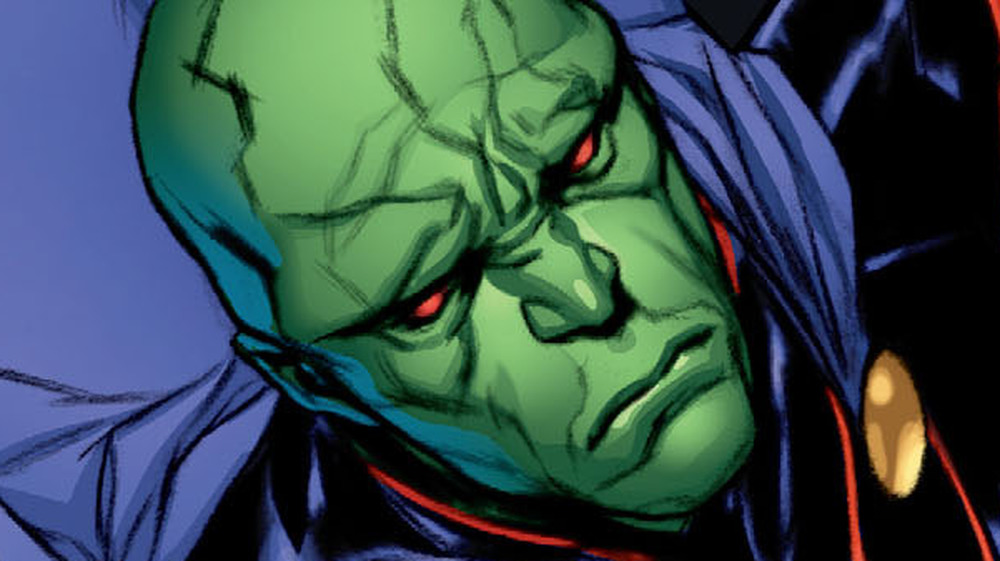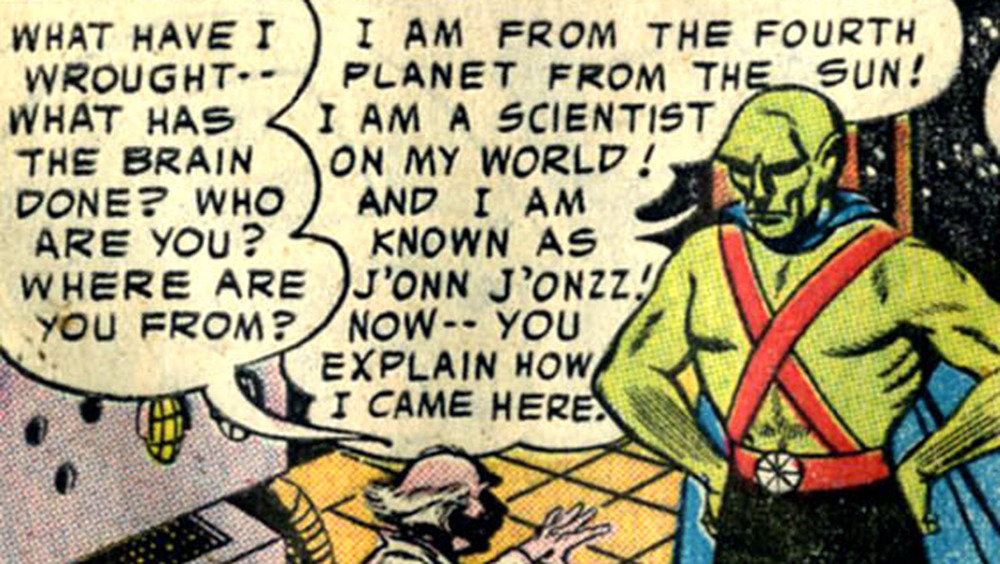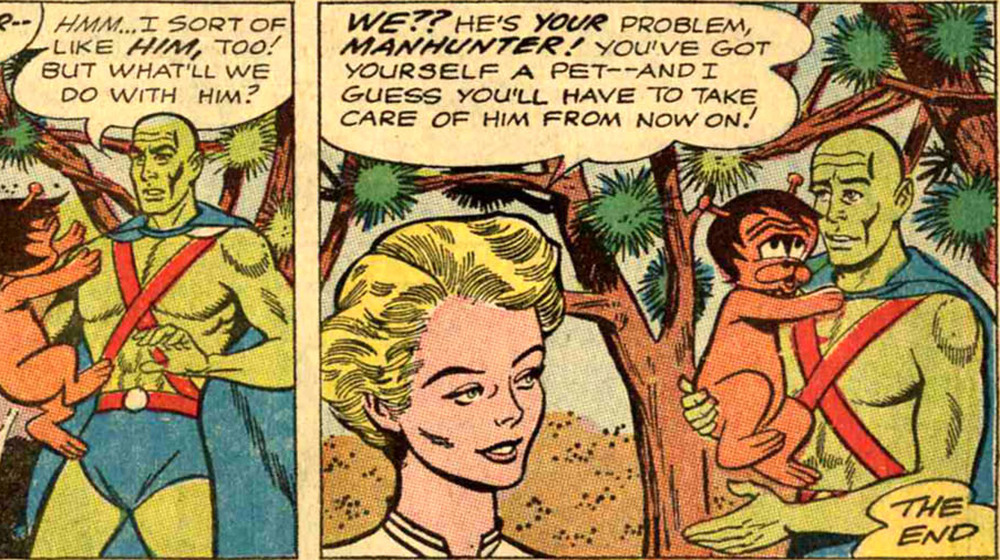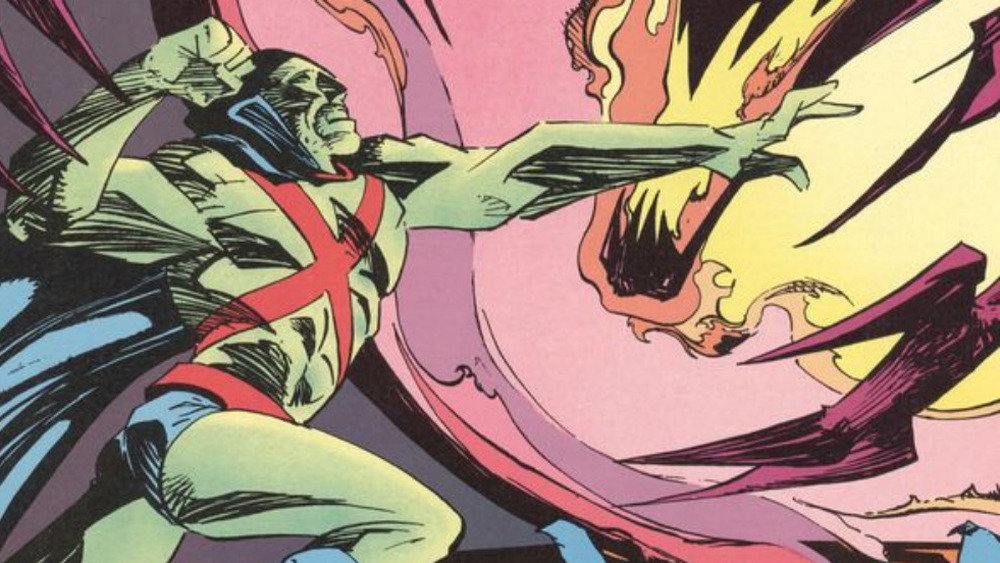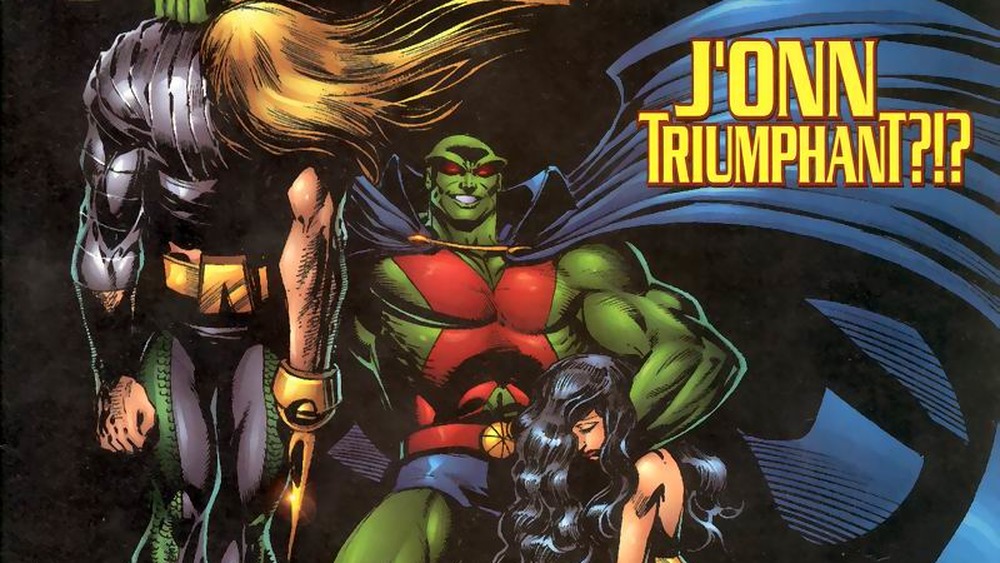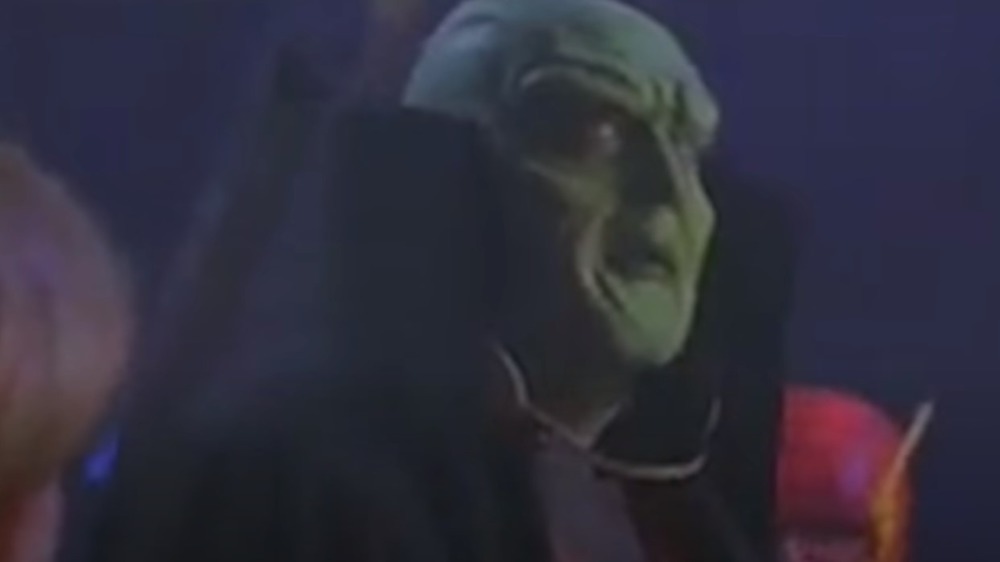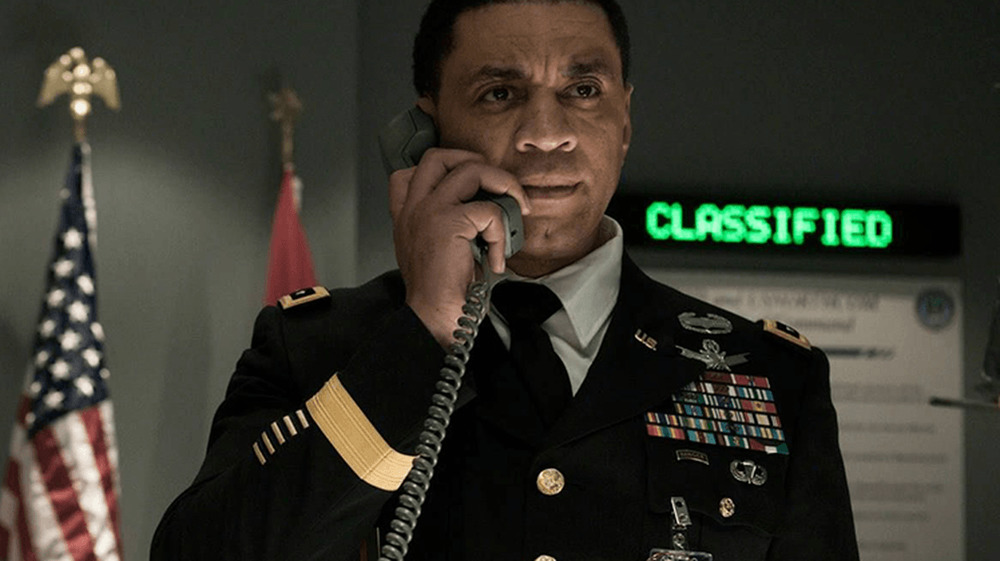The History Of DC's Martian Manhunter Explained
If you click a link and buy a product or service from a merchant, we may be paid an affiliate commission.
He is power. He is justice. He is somehow the Justice League member with the silliest name, even in the face of Elongated Man, Phantom Stranger, and, if you want to count Justice League Dark, Bobo T. Chimpanzee.
Martian Manhunter has always been one of DC's most striking characters, thanks to his iconic green hue and Zardoz-adjacent outfit. He's a classic outsider, dedicated to the protection of his adopted home. He's also, without a doubt, one of DC's more impenetrable heroes, with nearly 70 years of backstories, crises, retcons, inconsistencies, and pet space monkeys in his proverbial closet. If you want to understand the superhero otherwise known as J'onn J'onzz, there's a lot to go through.
Now, with Martian Manhunter having made his debut in Zack Snyder's Justice League — which hit HBO Max in all its four-hour-long glory on March 18, 2021 – it seems like a good time to take a studious look at this crime fighter from another world. We take you now to the world of yesteryear, when the Justice League was still a glimmer in Gardner Fox's eye and Superman was just beginning to realize that he could shoot tiny duplicate Supermen out of his fingers.
The origins of Martian Manhunter
It all started back in November 1955, in the pages of Detective Comics #225. For a good gauge of where the DC universe stood narratively at this point, the main story in the issue was about a paunchy James Gordon, Gotham City's dedicated police commissioner, winning a contest to be Batman for a day. Detective Comics #225 also covered the adventures of Roy Raymond, TV Detective, and a four-panel story about Fearless Fosdick traveling a million years into the future, where mankind's descendants still extoll the coif-taming powers of Non-Alcoholic Lanolin Wildroot Cream Oil, available at your local druggist. And that's not even the half of it — literally.
In the back half of the issue, there's a story entitled "The Strange Experiment of Dr. Erdel." Readers are introduced to Professor Mark Erdel, world-famous scientist, and his remarkable new invention: "The robot brain of the century," by his reckoning. That's about as much explanation as we get. Erdel hits the power button on the contraption, hoping to use it to probe the cosmos.
There's a flash, then a crackle, and suddenly, J'onn J'onzz appears. He's an alien scientist from Mars, the fourth planet of our solar system, transported to Earth through the power of Erdel's invention. Erdel explains the circumstances of J'onzz teleportation, and states that it may take years to recalibrate the robot brain to send the visitor home. J'onzz takes the news like a champ and uses his inherent shapeshifting abilities to transform into a human man. The shock of witnessing this proves to be the last straw for Erdel, who promptly dies.
Now trapped on an unfamiliar world, the alien takes in his surroundings: Earth is a primitive place compared to Mars, and clearly in need of a lawman. Adopting the less obnoxiously punctuated moniker of John Jones, he sets off on an expository mission, displaying his powers of invisibility and telepathy — and pulling gold out of the ocean — to show Earth's citizens and DC Comics readers alike what he's made of. He then walks into the Middleton police precinct and immediately lands a job, despite getting scared twice when people light cigarettes in front of him. His one weakness (when he's in his alien form) is fire, which sounds dumb only if you put aside the fact that Batman's weaknesses are "everything, including fire" and the Green Lantern Yalan Gur was at separate times vulnerable to wood and the color yellow.
Martian Manhunter and the weirdness of Silver Age comics
Over the next few years, "the Manhunter from Mars" continues to work for the Middleton constabulary in the guise of John Jones, ace detective. As tended to happen in those days, his list of abilities got longer seemingly with every issue. In his second appearance, he exhibits telekinesis — or "Martian mind over matter," as he calls it. X-ray vision was then added to the roster, as were super-breath and the power to scare sharks away by turning green. All the while, the character waits for Martian technology to reach the point where it can bring him back home.
In 1959, during the earlier years of the Silver Age of Comics, the Martian Manhunter made the leap from secret detective to full-blown superhero. The following year, he became a founding member of the original Justice League of America in the pages of The Brave and the Bold #28, published in March 1960. In this groundbreaking issue, DC Comics unites the members of the Justice League: Batman, Superman, Wonder Woman, the Flash, and Aquaman (five of the six who appear in the live-action Justice League movie), as well as the Martian Manhunter, Green Lantern, an honorary member named Snapper Carr, who's pretty good at snapping. (How he didn't make it into the Snyder Cut of Justice League, we'll never know.)
When Martian Manhunter seemingly dies during a battle against the Martian artifact known as the Idol Head of Diabolu, things change. He no longer goes by John Jones, realizing that he can't continue masquerading part time as a human detective if he is to crush this enemy for good. The alien adopts the name Marco Xavier, successfully infiltrates the crime cartel called VULTURE (which doesn't stand for anything) by pretending he's the leader "Faceless," and then disbands it in April 1968's House of Mystery #173.
Things get pretty boilerplate for the Martian Manhunter for a while after that. Aliens occasionally show up, and he sends them back from whence they came. He partners up with a human assistant named Diane. In the tradition of so many Snarfs, Godzukis, and Scrappies Doo, the Martian Manhunter also adopts a funny pet sidekick named Zook. This was a relatively calm time for the benevolent alien, but he started appearing in the comics less and less after Superman gets a promotion to a legitimately active JLA member. The Martian Manhunter takes part in a Justice League mission in a March 1968 comic, and ten issues later, he leaves Earth to lead New Mars.
The Bronze Age and a new backstory
Martian Manhunter isn't seen very much after he pops up on New Mars in the early 1970s, bouncing between that planet and Earth a few times. At one point, his fellow JLA-ers Superman and Batman lend a hand in a fight on New Mars, proving the bond between Justice League members knows no interplanetary bounds. In 1984, the Martian Manhunter reenters the Justice League of America, coming back to Earth on a permanent basis and self-stylizing as John Jones once more (though he does have to address why he was gone for two decades).
The late 1980s saw DC scrubbing up its comics in hopes of achieving greater success. Justice League of America was given a sleeker name — just Justice League — in 1987. The new run highlights the Martian Manhunter's inherent comedic presence amongst the other members of the Justice League, and pads out his backstory. A year later, the character got his own comic miniseries, J.M. DeMatteis and Mark Badger's Martian Manhunter four-parter, that really altered his history.
Several big reveals come into play. Dr. Erdel didn't actually die when J'onn J'onzz shape-shifted, and the character's alien look is a fabrication — a blend of what Martians really look like and what humans look like. In reality, the Martian Manhunter more closely resembles a gangly parasaurolophus, according to this comic miniseries.
Additionally, the truth is that Martian Manhunter had been transported to Earth not just through space travel, but also through time travel. Martian Manhunter also reveals that the alien's people had died off thousands of years prior, giving him a classic "last of my kind" sci-fi spin. His family had burned to death in front of his eyes. He wife and daughter did, too. Basically, he had all the hallmarks of post-cancelation Doctor Who, plus flight and super-strength.
The strange '90s
The Martian Manhunter's stories became characteristically extreme and tough to follow in the '90s, with each story-purging retcon being swiftly followed by a litany of narrative cheat days.
The Martian Manhunter still fights the good fight alongside his Justice League fellows — both as himself and, through means of outside intimidation, as the necromancer Bloodwynd, with whom he was accidentally merged (that reveal comes after J'onzz-as-Bloodwynd joined the League). Doomsday knocks the Martian Manhunter around a bit, Blue Beetle finds out the truth of the situation, and then the merged characters get successfully separated.
Later, the Martian Manhunter gets wrapped up in the muder mystery investigation at the heart of 1992's American Secrets miniseries, and five years later, he helps found a new Justice League and fights off invasions of White Martians, the malevolent co-habitants of his home planet. He even becomes trapped for a time in the Phantom Zone, is made out to be a psychopath thanks to the dastardly deeds of his meddling brother Ma'alefa'ak, and uses his severed hand to regenerate his whole body after it's blown apart in an explosion. Plus, the comics revealed that John Jones, the Martian Manhunter's first assumed identity, was a real man who was tragically murdered ... and whom the alien pretended to be as a way to finish a legal mission.
By 1999, he'd developed even more powers, and could now absorb mass until he became the size of a mountain. Really, if he could've just gotten past his fear of matches, the guy would have been on top of the world.
The weirdness persisted. None of it could prepare fans for the character's live-action debut.
Martian Manhunter's first steps toward stardom
1997 saw the premiere of Justice League of America, a bizarre pop culture experiment seemingly drawn from a dozen different time periods. Its characters came from classic DC comics. Its mockumentary film style was a decade ahead of its time. Its comedy stylings seemed pulled directly from a future post-nuclear wasteland where laughter died centuries ago in a blinding wall of flame.
Here, fans got their first live-action Martian Manhunter, played by M*A*S*H's own David Ogden Stiers. He's portrayed as the leader of the Justice League, and is seen exhibiting powers ranging from shapeshifting to ... that's it. It wasn't a great movie.
From there, the Martian Manhunter train started to build up steam. The character debuted in Smallville during the show's sixth season, this time played by Phil Morris — in human form thanks to the limitations of TV special effects at the time. David Harewood would take up the baton in the Arrowverse, playing J'onzz in Supergirl, The Flash, and the Crisis on Infinite Earths crossover. In the world of animation, the Martian Manhunter has made more appearances than we have room to recount with over a dozen actors lending their voices to bring various iterations of this guy to life over and over again.
Martian Manhunter breaks into Hollywood
We've established that the character is beloved, ubiquitous, and responsible for founding one of the world's best-known superhero teams. So why haven't we seen a big screen version of Martian Manhunter?
We came close. Back in 2007, George Miller, the mastermind behind Mad Max (and, weirdly, Happy Feet) was all set to bring his vision of the Justice League to theaters. The story of what happened to Justice League: Mortal is an absolute roller coaster, with plenty of studio intrigue, Hollywood politics and, unavoidably, Armie Hammer. It's bananas. Importantly, Miller had tagged his frequent collaborator, Hugh Keays-Byrne — better known as Immortan Joe from Mad Max: Fury Road — to play the world's first major motion picture version of Martian Manhunter. Oh, what could have been.
Then, in 2013, Zack Snyder's Man of Steel introduced audiences to a military officer by the name of General Calvin Swanwick, played by Harry Lennix. Fan theories circulated that Lennix was secretly Martian Manhunter in disguise, and Snyder took a shine to the idea, planning a big reveal during the events of Justice League. While the theatrical cut of the film wound up Manhunter-free, the character's big day is now upon us, with extra scenes in Zack Snyder's Justice League confirmed to include Mars' biggest, greenest superhero.
